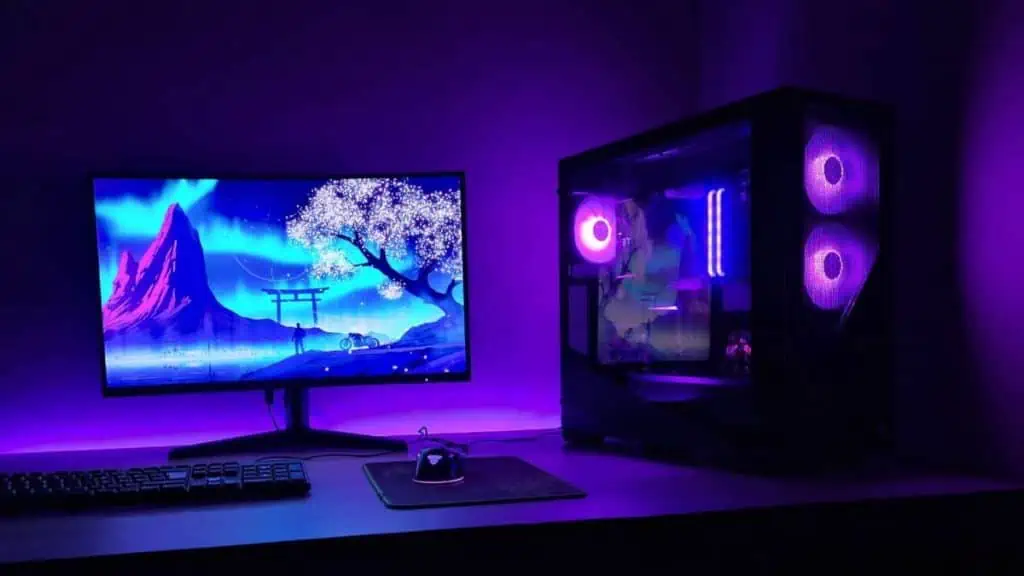Whether it be for better cooling or aesthetics, the best place to put your PC is on top of your desk. In fact, that’s the literal meaning of the term ‘desktop’!
Even if your desk has a limited space, it’s wise to place it somewhere elevated. This way, your PC will have proper airflow and the internal components won’t overheat.
You may utilize a separate table, purchase a dedicated shelf, or even mount it on the wall.
Placing your PC on the floor isn’t a bad idea either. You just have to make sure there’s proper ventilation, and the surface doesn’t accumulate too much dust. But this calls for frequent PC and workspace cleaning.
In this article, I’ll brief you on the best spots to place any rig. Also, I have provided some handy tips if you’re thinking of placing your PC case on the floor.
On Top of Your Desk
Anyone with a big workspace (especially users with curved desks) should definitely place their PC on top. The main reason for this is optimal airflow.
It also matters how well you position your PC. It’s best that you leave enough space at the back so the hot air can escape properly and there’s no cable clutter on the desk.
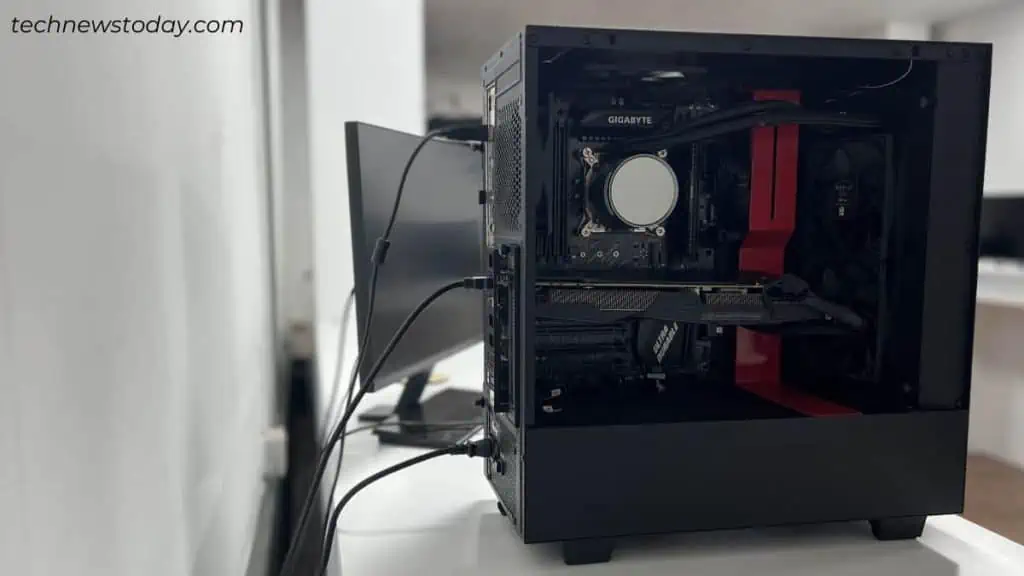
PC on top of the desk also lets more hot air dissipate from the top (if your case has vents). No doubt, it’s the best position for cooling!
You can even show off your high-end components, and with RGB lights, your setup looks aesthetically pleasing.
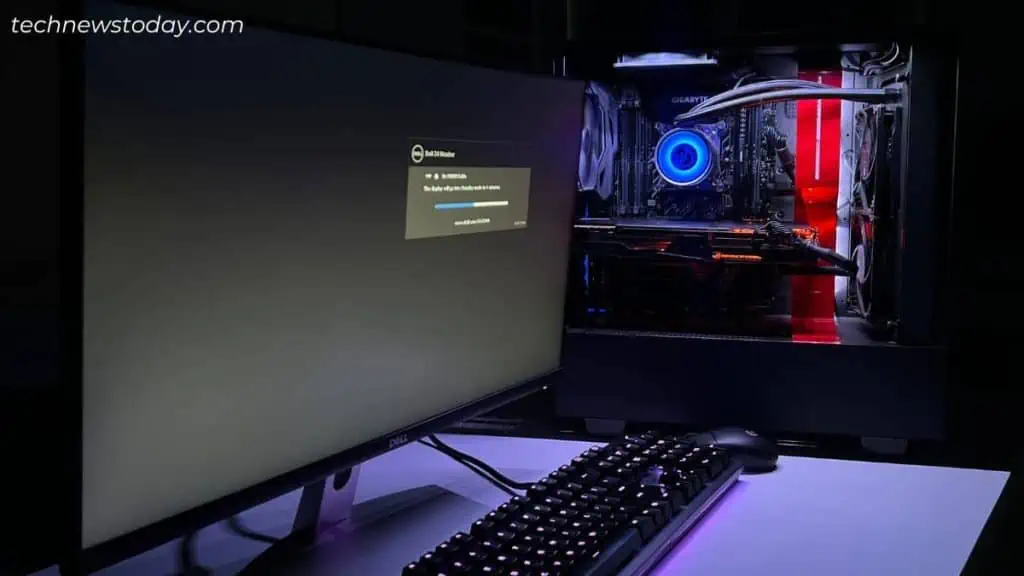
Not to forget that accessing the motherboard ports becomes much easier. But along comes the risk of accidental spills and fallover.
You also don’t need to worry about excessive dust accumulation. This calls for cleaning your PC and components less often. But it does vary on other factors, like how dusty your room gets, whether you own a pet, too humid room, etc.
- Good airflow and cooling.
- Better aesthetics.
- Less effort in cable management.
- Easy access to ports and cables.
- Less dust accumulation.
- Doesn’t require frequent cleaning.
- Requires enough desk space.
- Risk of accidental spill.
- Risk of fallover (if you place it at the edge).
- Cable clutter (if cable management isn’t done properly).
Use a Separate Shelf/Table/Stand
The major issue with most users is limited desk space. If you’re going to place the PC on top of the table, it will appear too bulky and there’s more risk of falling over.
Don’t put your PC on the floor or purchase an expensive desk immediately! A better and more budget idea is to go for a separate table/stand that’s sturdy enough to handle its weight.
This way, you even retain the advantages of proper airflow, cooling, and less dust buildup of placing the PC on a desk.
You can get dedicated tower stands or shelves for PC cases. My personal favorite is the rolling stands with wheels.
Instead of purchasing one, our team has gone for a DIY stand. We can now keep the PC case somewhere below the desk, ensuring it’s elevated and not placed directly on the floor.
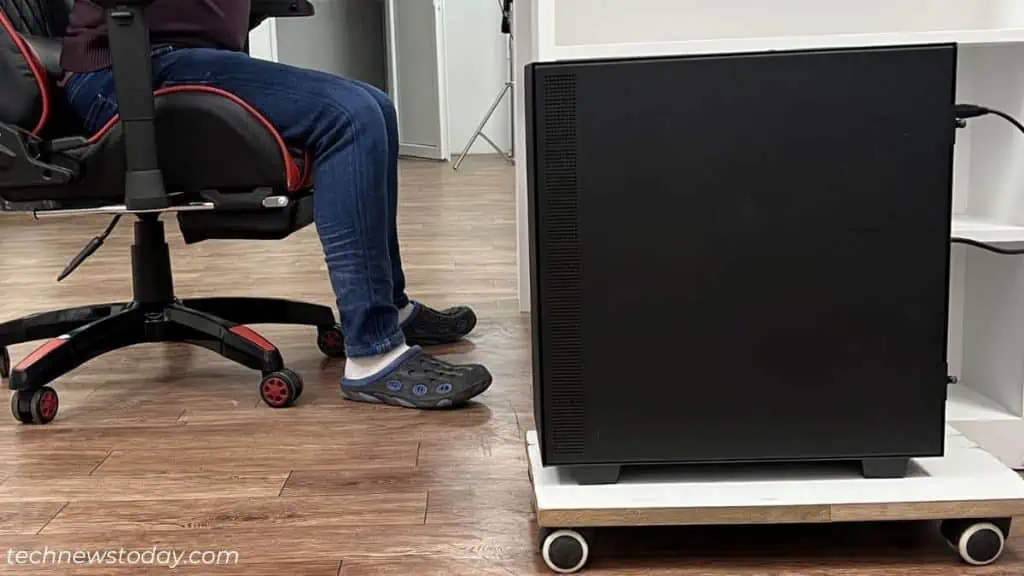
Even reaching the ports is much easier as we can move it back and forth. If we had gone for a separate table or shelf, reaching the cables would have been more difficult.
One thing you need to sacrifice is aesthetics. Cable management can also be a little tricky. You might require longer cables depending on how far your PC is placed.
- Saves desk space.
- Good airflow and cooling.
- Less dust accumulation and doesn’t require frequent cleaning.
- Safe from accidental spills.
- Risk of falling is heavily reduced.
- Tidier desk with no cable clutter.
- If kept far, it can impact the aesthetics.
- You might require longer cables and managing them can be tough.
- Accessing the motherboard ports can be difficult (unless kept near).
Wall Mount Your PC
This is a bit difficult approach but an excellent location to achieve better cooling, airflow, and aesthetics. In fact, mounting the PC is one of the best options for users who have second thoughts on getting a case.
Along with appropriate skills, it also takes a lot more time to set up. Even with so much effort, there’s a risk of physical damage, the setup requires frequent cleaning, and maintaining and upgrading components can be challenging.
Clearly, this is applicable mostly to enthusiasts. If you’re ready to put in extra effort, I can assure you that mounting the PC on your wall won’t disappoint you.
- Budget friendly as you can go for open-air build.
- Best for aesthetics.
- Proper airflow and cooling.
- Saves desk space.
- Takes extra time and effort to set up.
- Excessive dust can build up if not cleaned regularly.
- Risk of falling, liquid spills, and physical damages.
- Difficult to maintain and upgrade components.
Utilize Desk Cabinet the Right Way
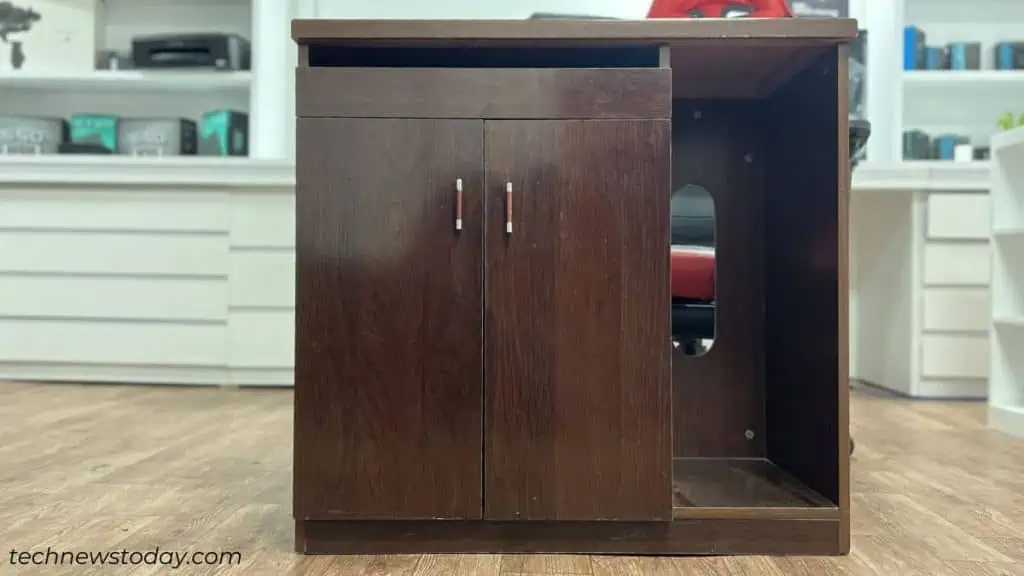
Some old computer desks come with a separate cabinet for placing your PC. There are grommet holes that make cable management a breeze and even prevent accidental kicks and knocks.
If you have an old PC case that isn’t aesthetically pleasing and you crave more desk space, the cabinet is a worthy location for sure.
However, the PC’s rear end gets blocked which affects the overall airflow. It’s also difficult to access the I/O panel.
So, is it a mistake placing the PC in the desk cabinet? Not exactly, if the backside of the cabinet has enough space for airflow.
In case your cabinet doesn’t have a hole, I highly recommend drilling it on your own.
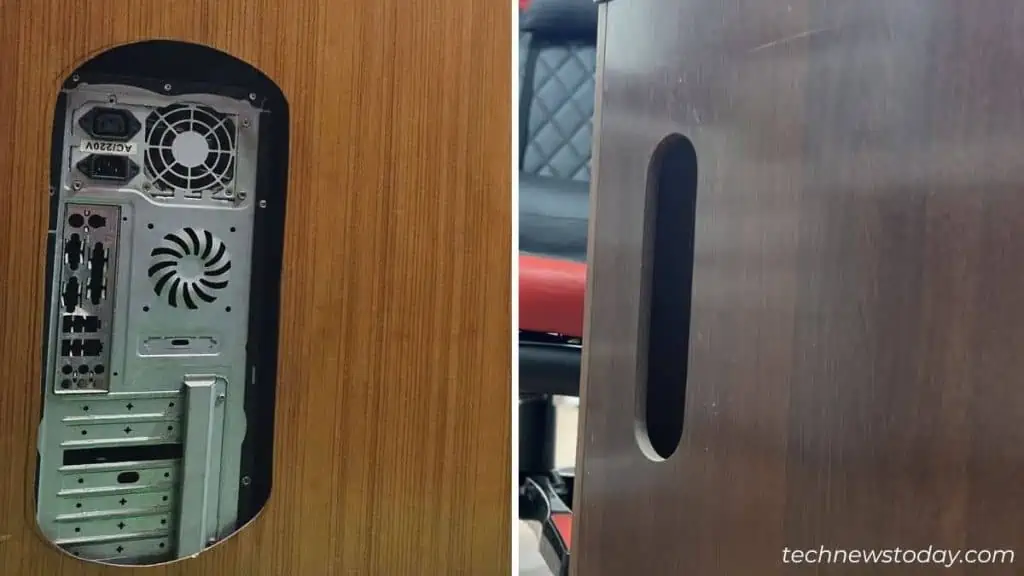
Also, make sure to position the desk in such a way that hot air can escape properly from the back. You should also be able to access the ports from behind.
- Better cable management.
- Separate cabinet prevents accidental kicks.
- Saves desk space.
- Doesn’t add any aesthetic value.
- Hard to reach the I/O ports.
- Poor airflow (if the desk isn’t positioned the right way).
Placing PC on Floor? Keep These Things in Mind
If your PC case doesn’t add any aesthetic value or you just wish to keep the PC away from your working space, placing it on the floor is fine.
However, the dust and pet hair can get trapped inside the chassis much faster. That’s because the floor tends to accumulate most dust in any room.
The low pressure around the intake fans creates negative pressure inside the chassis, which attracts more dust. That’s the reason most professionals never advise placing your PC on the floor.
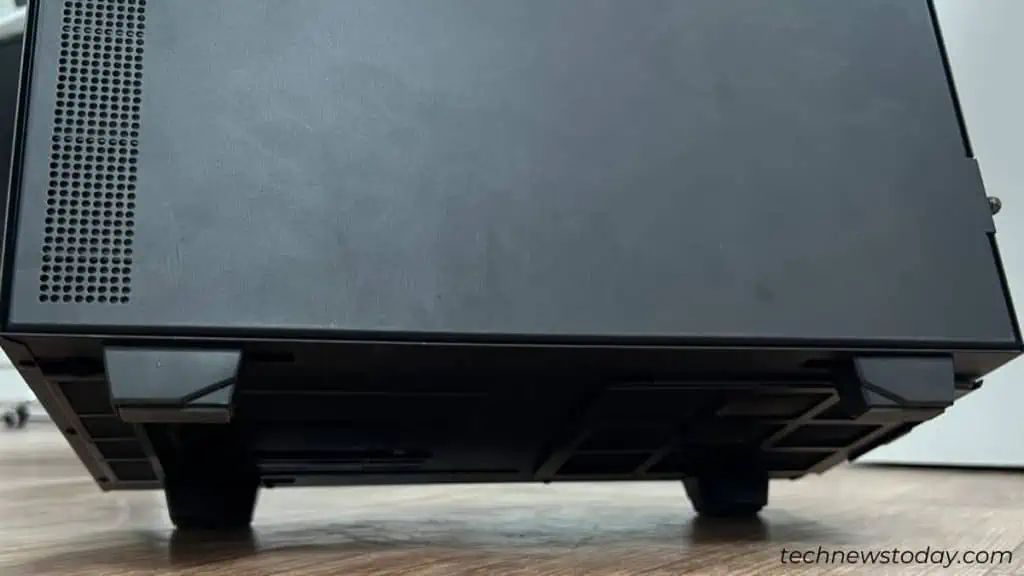
Modern cases come with non-slip rubber feet that slightly elevate the height. If you have a similar casing, placing your PC on the floor won’t have adverse effects.
Whether your room is parqueted, laminated, or has linoleum flooring, the risk is much reduced than the one with carpet. That’s because carpets gather more dust and static electricity.
To prevent all these, place a wooden board/plank underneath. Also, clean your surroundings and the PC every single week or at least once a month.
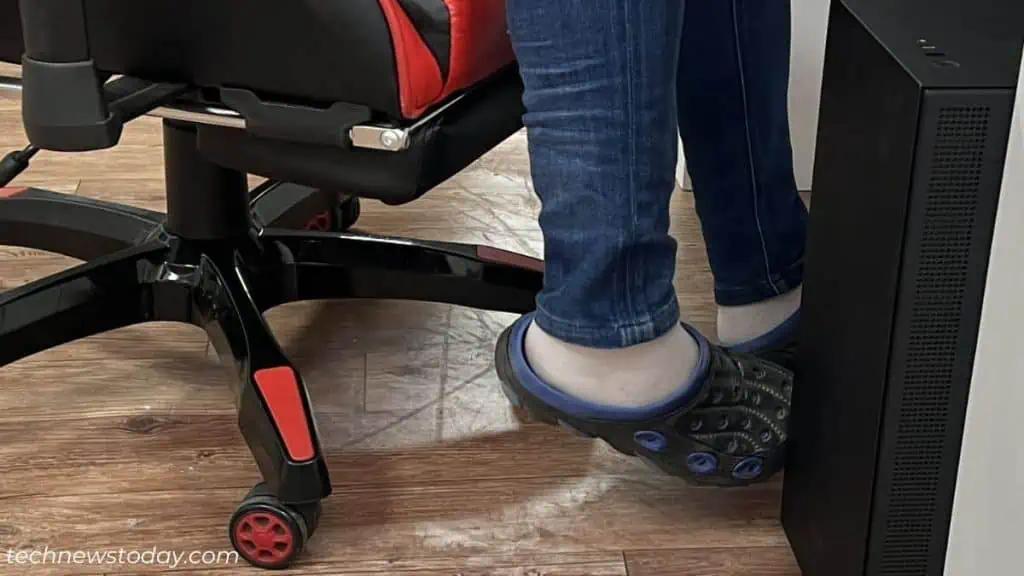
Not to forget that you might accidentally kick the PC case, which leads to scratches or even knock it down, damaging the components within.
Make sure there’s enough legroom for yourself. Place the PC case out of the desk enclosure (away from your feet) if you have to.
Besides, I highly advise getting a PC case that’s best for airflow.
- Saves desk space.
- Poor airflow and cooling.
- Heavy dust buildup and requires frequent cooling.
- Prone to static discharge (if placed directly on a carpeted floor).
- No aesthetics.
- Prone to accidental kicks and knocks.
- Hard to reach back panel ports.

